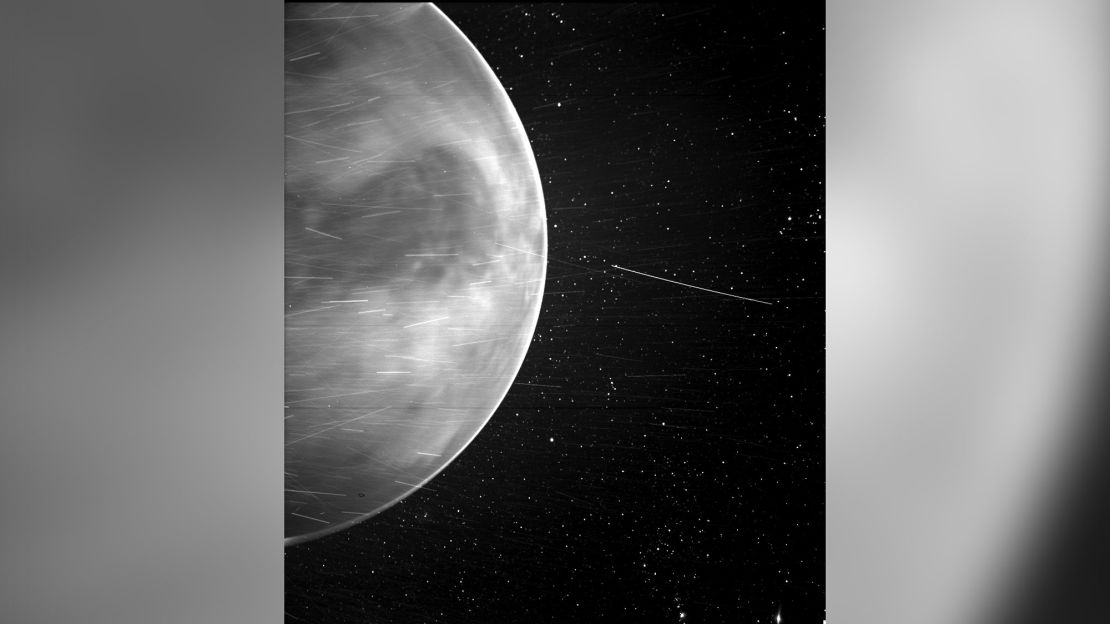While on a journey to study the sun, NASA’s Parker Solar Probe has captured an incredible new view of Venus.
The mission, which launched in 2018, is intended to study the sun and reveal some of its mysteries. Over the course of seven years, the probe will travel through the sun’s atmosphere and come closer to the surface of our star than any spacecraft before it.
Venus is instrumental to the probe’s success. The spacecraft uses the gravity of Venus as it swings around the planet, called a gravity assist, to help bend the probe’s orbit and bring it closer and closer to the sun.
During one of these Venusian flybys on July 11, 2020, the probe snapped an amazing image that shows an unexpected side of our planetary neighbor. This was the third Venus gravity assist for the Parker Solar Probe.
The spacecraft’s WISPR instrument, or Wide-field Imager for Parker Solar Probe, was actively taking images during the flyby and captured the nightside, or side facing away from the sun, of Venus. The image was taken 7,693 miles away from the planet.
A faintly glowing rim can be seen around the planet, which scientists believe to be “nightglow,” or the “light emitted by oxygen atoms high in the atmosphere that recombine into molecules in the nightside,” according to NASA.
Bright streaks seen in the image are the result of space dust and cosmic rays, or charged particles, reflecting sunlight. The streaks look a little different depending on how fast the probe is traveling.

There is also a noticeably dark feature in the center of the image. It’s known as Aphrodite Terra, which is the largest highland region on Venus. The reason it looks so dark in the image is because it’s actually at a temperature that is 85 degrees Fahrenheit lower than the surrounding areas.
The WISPR instrument was designed for the probe so it can gather images of the sun’s corona, or outer atmosphere, in visible light. The imager can also capture the solar wind in action. The solar wind is a steady stream of energized particles that flow out from the sun.
When turned to look at Venus, WISPR surprised the team’s scientists. Instead of seeing clouds, the surface of Venus was revealed. Venus has an incredibly thick atmosphere that has proven difficult to peer through with instruments on other spacecraft in the past.
“WISPR effectively captured the thermal emission of the Venusian surface,” said Brian Wood, an astrophysicist and WISPR team member from the US Naval Research Laboratory in Washington, DC, in a statement.
Akatsuki is a Japanese orbiter that has been circling Venus since 2015. It enables scientists to study the weather patterns on Venus, look for lightning within the planet’s thick clouds and search for signs of active volcanoes.
What WISPR was able to do in visible light is similar to what Akatsuki has captured of Venus in near-infrared, Wood said.
Angelos Vourlidas, the project scientist for WISPR at the Johns Hopkins Applied Physics Laboratory in Maryland, coordinated an imaging campaign with the Akatsuki mission.
One of two things is happening. Either WISPR is actually sensitive to infrared light and is picking that up when it passes Venus – which could open up possibilities to study dust around the sun, or the imager is looking through the atmosphere of Venus and right down to the surface.
“Either way, some exciting science opportunities await us,” Vourlidas said in a NASA release.
Parker Solar Probe just conducted its fourth flyby of Venus on February 20, passing 1,482 miles from the planet’s surface, so the team planned another set of observations of the Venusian nightside. That data should be received by the end of April, according to NASA.
This flyby set Parker Solar Probe on course for its eighth and ninth close passes by the sun, which will occur on April 29 and August 9.
Each pass of the sun leads the probe to break its own previous record, coming more than a million miles closer than the pass before. These passes will bring the probe 6.5 million miles from the sun’s surface.
“We are really looking forward to these new images,” said Javier Peralta, an astrophysicist from the Akatsuki team. Peralta was the first to suggest a Parker Solar Probe collaboration with the Japanese mission.
“If WISPR can sense the thermal emission from the surface of Venus and nightglow — most likely from oxygen — at the limb of the planet, it can make valuable contributions to studies of the Venusian surface.”






